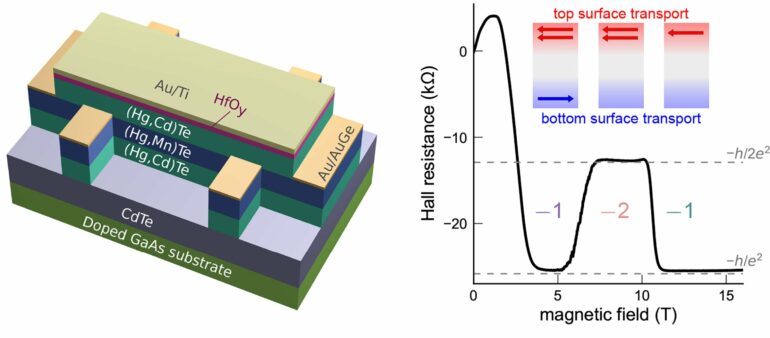Experimental and theoretical physicists from the Würzburg Institute for Topological Insulators have observed a re-entrant quantum Hall effect in a mercury telluride device and have identified it as a signature of parity anomaly.
Topological insulators are materials that can conduct electricity, but only on their surface or edges. No current flows inside them. They are the subject of intensive research worldwide because they have unique electronic properties that could improve the efficiency of quantum computers, for example, and be used for other technologies such as encryption and the secure transmission of data.
Researchers from the Institute for Topological Insulators and the Institute for Theoretical Physics and Astronomy at Julius-Maximilians-Universität Würzburg (JMU) now present an unusual quantum Hall effect that was observed on a microscopic device made of the topological insulator material mercury telluride (HgTe). Their findings are published in the journal Advanced Science.
Clear experimental observation
In the mercury telluride device, electrons at the top and bottom surfaces behave as relativistic Dirac particles. As predicted, but not experimentally verified by particle physics, Dirac particles should be subject to the so-called parity anomaly. In solid-state experiments, the parity anomaly leads to an effect called spectral asymmetry, that can be measured as an unusual change in the electrical resistance.
“The parity anomaly has been predicted to occur in solid-state materials since the 1980s. A famous theoretical proposal is the model proposed by Haldane (Nobel Prize in Physics in 2016). We have identified another consequence of the parity anomaly which is the first one to be experimentally verified,” says Professor Ewelina Hankiewicz.
Effect is not specific to just mercury telluride
The JMU physicists have realized this two-dimensional Dirac physics on a single surface of the three-dimensional topological insulator. “We observe an unconventional re-entrant quantum Hall effect that can be directly related to the occurrence of spectral asymmetry in a single topological surface state. The effect is generic for any topological insulator, not specific to just mercury telluride. The universality of the result is what makes it so exciting,” says Dr. Wouter Beugeling.
Two challenges had to be overcome to realize these new findings. First, the signature of spectral asymmetry had to be identified among the other features in the measured electrical resistance. Second, the device had to be controlled in such a way that the effects from the two surfaces did not cancel each other.
High level of control allows further explorations
“This observation shows that the high level of control we have in this device allows us to explore many more interesting aspects of topological insulator physics than before,” says Professor Laurens Molenkamp.
A key factor in achieving the experimental accuracy required for this observation was the high quality of the HgTe material, which was produced in the molecular beam epitaxy facility at the Würzburg Institute of Physics. Molecular beam epitaxy (MBE) is a technique for producing wafer-thin layers of material with customized electronic, optical and magnetic properties. With MBE, layer structures can be precisely built up atom layer by atom layer.
More information:
Li‐Xian Wang et al, Spectral Asymmetry Induces a Re‐Entrant Quantum Hall Effect in a Topological Insulator, Advanced Science (2024). DOI: 10.1002/advs.202307447
Provided by
Julius-Maximilians-Universität Würzburg
Citation:
Physicists demonstrate parity anomaly in a topological insulator (2024, March 26)



